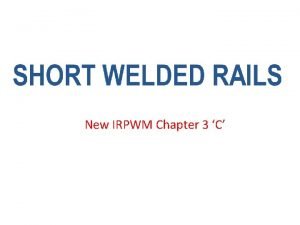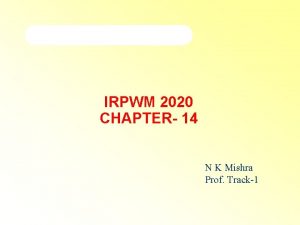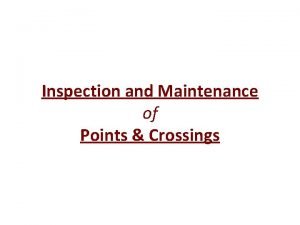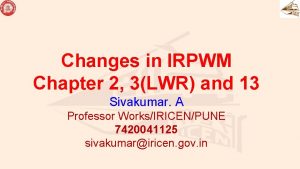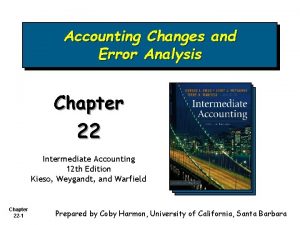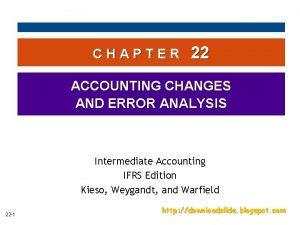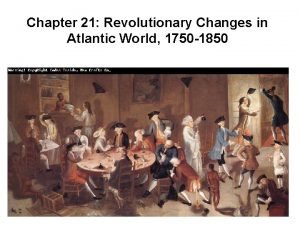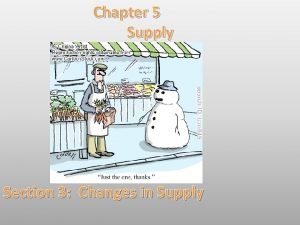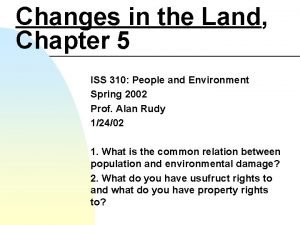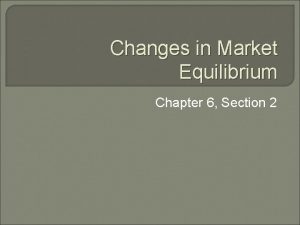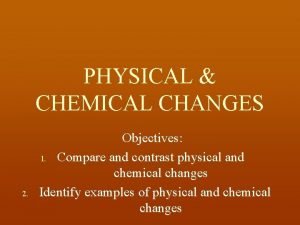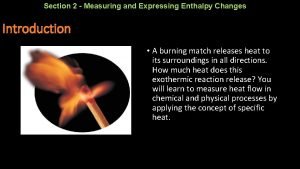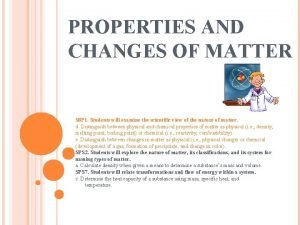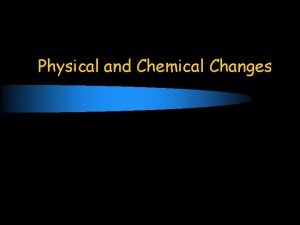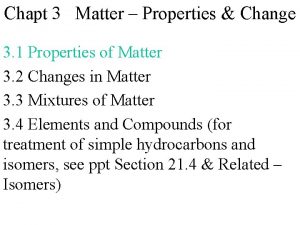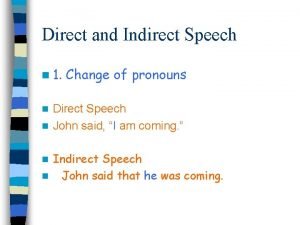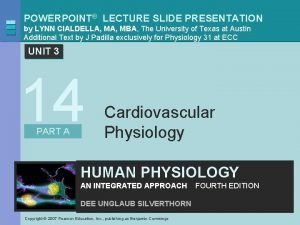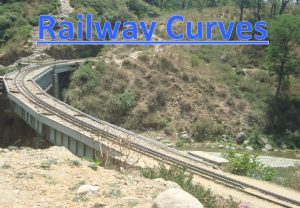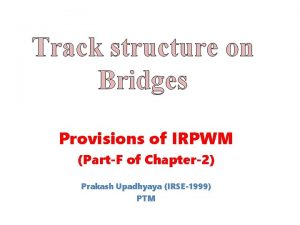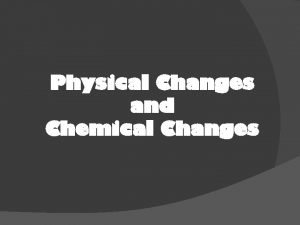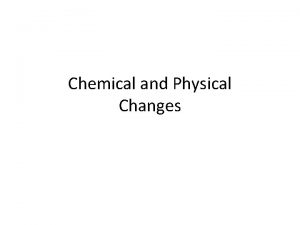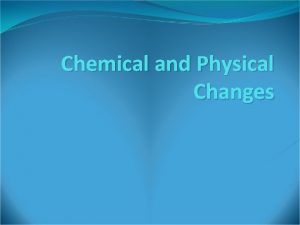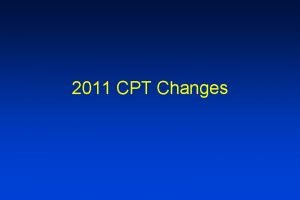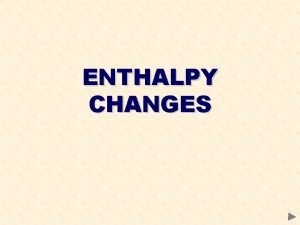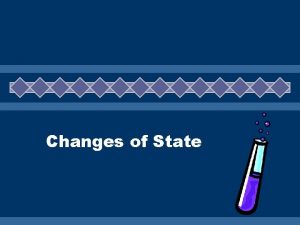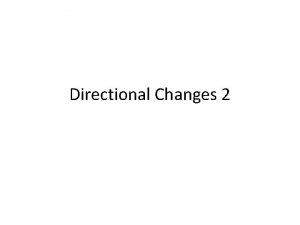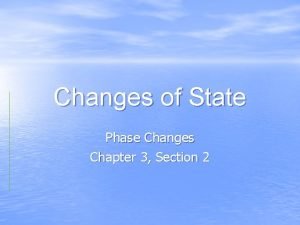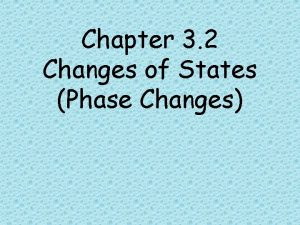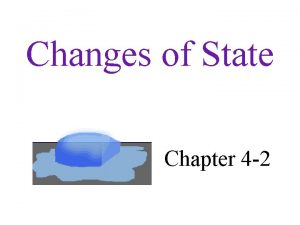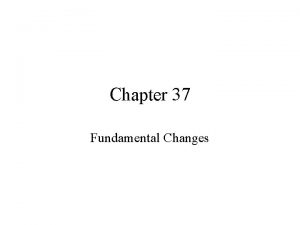Changes in IRPWM Chapter 2 3LWR and 13










































- Slides: 42

Changes in IRPWM Chapter 2, 3(LWR) and 13 Sivakumar. A Professor Works/IRICEN/PUNE 7420041125 sivakumar@iricen. gov. in

Chapter 2 Track Structure and its Components

Additions/deletions/modifications CHAPTER 2 - Track Structure and its Components Items Added Items Modified/ Shifted Remarks List of different BG routes and all MG Routes (Para 202) --- Only classification of routes mentioned Classification of Routes changes frequently, hence not required. --- Minimum Track Structure for passenger train running at 110 kmph and beyond and Para- 202 --- Vide RB L No. 2018/CEII/TS/25 T of Dated 14. 03. 2018. and letter no 2003/CE-II/TS/5 Vol. 1 dtd. 04/05/2005 --- Referred from IRS T-12. Items Deleted --- Details of 52 kg and 60 kg Rails, Chemical composition, Different qualities of Rails, Colour Coding (Section ‘A’ of Chapter 2)

ROUTE CLASSIFICATION Classification of Lines–on the basis of the future maximum permissible speeds (1) Group ‘A’ – Speeds up to 160 km/h (2) Group ‘B’ – Speeds up to 130 km/h (3) Group ‘C’–Suburban Sections of Mumbai, Delhi, Chennai and Kolkata. (4) Group ‘D’ Special – Speeds up to 110 km/h & the annual GMT is 20 or more. (5) Group ‘D’– Speeds up to 110 km/h & the annual GMT is less than 20 GMT. Note – While classifying route, in case of double and multiple lines, annual GMT on each line shall be considered separately and classified based on the highest GMT on any one line. (6) Group ’E’ – All other Sections and branch lines with speed up to 100 km/h.

Track Structure for speeds beyond 110 kmph of Passenger carrying train on BG IR Speed Rails Sleeper Density Ballast Cushion Switch Crossing SEJ Bridge Sleepers Level Crossings Fencing Curves Speed above 110 kmph and up to 130 kmph 60 kg 90 UTS PSC at 1660 Total 300 clean 150 Thick Web Switches on all turnouts CMS Improved Type H – Beam Sleepers/Composite sleepers Interlocked All along the track Shall be suitably realigned with proper transitions. Maximum permissible cant of 165 mm, subject to the consideration of maximum cant excess for the slowest moving train. survey of each curve including the fixed installation and thereafter realignment should be undertaken keeping all the constraints in view. With a cant deficiency of 100 mm, the maximum permissible speed on 2 degree curve works out to be 130 kmph for 165 mm cant.

Track Structure for speeds beyond 110 kmph of Passenger carrying train on BG IR Speed Rails Sleeper/ Density Ballast Cushion Switch Crossing SEJ Bridge Sleepers Level Crossings Fencing Curves Speed above 130 kmph and up to 160 kmph 60 kg 90 UTS PSC at 1660 - Wider and Heavier PSC sleeper - used during renewals Total 350 clean 150 Thick Web Switches on all turnouts Weldable CMS Improved Type H – Beam Sleepers/Composite sleepers No Level crossing All along the track Shall be suitably realigned with proper transitions. Maximum permissible cant of 165 mm, subject to the consideration of maximum cant excess for the slowest moving train. survey of each curve including the fixed installation and thereafter realignment should be undertaken keeping all the constraints in view. With a cant deficiency of 100 mm, the maximum permissible speed on 1 degree curve works out to be 160 kmph for 165 mm cant.

Additions/deletions/modifications CHAPTER 2 - Track Structure and its Components Items Deleted Items Added Items Modified/ Shifted --- Joggled Fish Plate (Para 206) --- Details of Concrete Sleepers with their Drawing Numbers (Para 209, 208) --- Details of Elastic Fastenings with Drawing Numbers (Para 210) --- --- Remarks Referred from Track Manual Referred from RDSO Drawings and RB Guidelines. Classification of formation requiring Incorporated as per treatment recent ACS no 154. (Para 219)

Additions/deletions/modifications CHAPTER 2 - Track Structure and its Components Items Modified/ Shifted Remarks Items Deleted Items Added --- Details of Glued Insulated Joint (Para 223) --- Referred from Glued Joint Manual Para 3. 3 & 3. 5. Details of Wooden, ST, CST-9 sleepers (Para 245, 246, 247) --- --- Slip Siding , Catch Siding (in terminology --- Referred from G & SR of CR Para No. 3. 50 -1 (b)

Fish plates: Fishplates are used to join the ends of rails using fishbolts and other fittings such as washers, etc. Joggled fish Plates: Joggled fish plates with clamps or with far end bolts are used at welded joints or at rail fracture locations. Combination Fish-Plates– A set of four combination fishplates is to be used at joints of two different rail sections. The 4 fishplates are different from each other and are marked I. R. (Inside Right), O. R. (Outside Right), I. L. (Inside Left) or O. L. (Outside Left) apart from their drawing numbers. These are manufactured to comply with RDSO specification, IRS-T-1. S No Component DRG. No 1 T-090(M) 2 T-1898 Fish Plate 3 T-5915 4 T-5916 5 Joggled Fish T-5551 6 EDO/T-2242 -43 Plate 7 EDO/T-2246 -47 8 T-5849 9 T-5848 10 Combination T-696 to 699 Fishplate T-6594 TO-6597 11 DESCRIPTION Fish Plate For 52 Kg/M Rail. Fish Plate For 60 Kg/M Rail. Fish Plate For 52 Kg/M Rail (1 Meter Long) Fish Plate For 60 Kg/M Rail (1 Meter Long) Joggled Fish Plates & Clamps for Rail-Fracture B. G. For 52 Kg. Joggled Fish Plates For 75 mm Wide Gap A. T. Weld For 52 Kg with C. I. Block Joggled Fish Plates For 75 mm Wide Gap A. T. Weld For 60 Kg (UIC) With C. I. Block Joggled Fish Plates for Use on Welded Joint for B. G. 60 Kg. Joggled Fish Plates for Use on Welded Joint for B. G. 52 Kg. Fish Plate Combination For 60 Kg (UIC) And 52 Kg Combination Joggled Fish Plates For 60 Kg. (UIC)/52 Kg Rails With C. I. Block For B. G.

Concrete Sleepers Mono-block & twin-block Types - IR Uses the Mono-block type Provides longitudinal, lateral stability required for LWR. Manufactured to RDSO specification No IRS: T-39 (Plain Track) & IRS: T-45 (Turnout sleepers). Due to the Flat bottom are suitable for mechanised tamping. Can be identified by the drg no. and code of sleeper manufacturer with year of manufacture engraved on the top end surface of sleepers. Tested for electrical resistance at the time of manufacture & marked by paint with “FTC” - Fit for Track Circuiting and “NFTC” - Not fit for track Circuited location. If used in yards with FP/SWR, sleeper spacing at FP joint shall be kept uniform, preferably with 1 m long fishplates at such joints.

Type DRG. No DESCRIPTION OF PSC SLEEPER Ordinary T-2495 52 kg Rail designed for 22. 9 t Axle load PSC T-2496 60 kg / 52 kg Rail designed for 22. 9 t Axle load sleepers T-8527 60 kg /136 RE Rail designed for 25. 0 t Axle load Slack RT-4183 -4186 For Curve with Check Rail for 60 Kg Rail Gauge RT-8621 -8624 Curve with Check Rail for 136 RE / 60 Kg rail for 25 T Sleeper RT-5738 – 5740 For Curve with Check Rail for 52 Kg Rail RT-4148/4148 A LC for 60/52 kg running rail & 52 kg check rail LC RT-8671 (25 t) LC for 25 T axle load SEJ RT-4149 SEJ RT-6253 SEJ (with 300 mm max: gap) 60 kg(UIC) rail on Br. App. RT- 4865 1 in 8 ½ Fan shaped layout RT- 4218 1 in 12 Fan shaped layout P&C RT- 6068 Derailing switch Shallow RT-4852 Shallow sleeper (160 mm) deep Depth RT-8326 Shallow sleeper with Guard Rail

GUARD RAIL AND RERAILING RAMPS Component DRG. No Fixing of T-4088 to 4097 Guard rail on ballasted Deck bridges* T-8672 to 8680 Re-Railing Ramp RT-6420 -6440 RT-8265 -8291 DESCRIPTION PSC Guard Rail Sleeper for Use on Bridge Approach Sleepers With 60/52 Kg Running Rail & 60/52 Kg/90 R Running Rail PSC Guard Rail Sleeper for wider sleeper 25 T Re-Railing Ramp On 52 Kg Running Rail Re-Railing Ramp On 60 Kg Running Rail Provision of guardrails on PSC sleeper for bridges on sharp curves for more than 5° curves shall be as per PSC sleeper drawing No. RDSO/T-8695 or RDSO/T-8757 (wider sleeper) having arrangement for provision of check rail along inner rail and guard along outer rail.

APPROVED FITTINGS TO BE USED ON COMPOSITE SLEEPERS Drawing No / part No 60 kg/m Rail 52 kg/m Rail MS Bearing plate RDSO / T-1033 RDSO /T -10671 Rail screw (For use with bearing plate) RDSO / T-1035 RDSO / T -10675 Rail screw (For use without bearing plate) RDSO / T-1034 RDSO / T 10673 Hook Bolts B 003/ M Plate Screw (For fixing walkway) T-10679 Fittings

Elastic Rail Clip (ERC): Manufactured from Silicomanganese Spring steel by RDSO Approved Suppliers as per RDSO specification IRS-T: 31. They offer a designed Toe load at design deflection. ERC type ERC-J Mk- III Mk-V Anti-theft RDSO Drg Toe load Toe def. Dia. Approx. no. (kg) (mm) Weight (kg) RT-8258 650 8. 5 20. 64 1 RT-3701 850 -1100 13. 5 20. 64 0. 91 RT-5919 1200 -1500 13. 5 23/20. 64 1. 08 RT-6254 850 -1100 13. 5 20. 64 0. 937

Grooved Rubber Sole Plate (GRSP): Manufactured from rubber compound to RDSO specification No IRS –T - 47, Absorbs high frequency vibrations, shocks & reduces noise. RDSO Drg No RT-3703 RT-3711 RT-3709 RT-4218, RT-4219, RT-4220 RT-4865, RT-4966, RT-4967 RT-6068 RT-5836 RT-4732, RT-4733, RT-4734 RT-4865, RT-4866, RT-4867 RT-6154, RT-6155, RT-4220 RT-6279, RT-6280, RT-4967 RT-4159 RT-5163 RT-5156 RT-5199 GRSP 8292 to 8295 Usage 6 mm Tk - 52 kg Rail and 52 kg Sleeper 6 mm Tk - 52/60 kg Rail and 60 kg Sleeper 10 mm Tk - 52/60 kg Rail and slack gauge PSC sleeper RT-4183 -4186 Turnout 1 in 12 - 60 kg (for Layouts - Assembly, Switch and Crossing) Turnout 1 in 8. 5 - 60 kg (for Layout Assembly, Switch and Crossing) 60 Kg for Derailing Switch 52 Kg for Derailing Switch Turnout 1 in 12 - 52 kg (For Layout Assembly, Switch & Crossing) Turnout 1 in 8. 5 - 52 kg (For Layout Assembly, Switch & Crossing) Turnout 1 in 12 with TWS 60 kg (For Layout Assembly, Switch & Crossing) Turnout 1 in 8. 5 with TWS 60 kg (For Layout Assembly, Switch & Crossing) 6 mm thick GRSP for SEJ 6 mm thick GRSP for 52 Kg guard rail on channel sleeper 10 mm thick GRSP for 60 kg running rail on channel sleeper 10 mm thick GRSP for 52 Kg running rail on channel sleeper 6 mm thick GRSP with horns for Turnouts (1 in 12 & 1 in 8. 5)

Composite GRSP with two layers of different types of rubber, for improved performance, developed, the top layer having higher modulus of elasticity (harder) while bottom is of softer material. RDSO specifications for CGRSP (provisional) - RDSO / M&C / RP-198 / 2006 for 6. 2 mm & RDSO / M&C / RP-200 / 2007 for 10 mm. The harder layer should be kept in contact of Rail. Thus, the surface of CGRSP where manufacturer’s initials are embossed should be placed on rail seat, facing up. Description/Usage RDSO Drg No For 52 kg / 60 kg Rail on PSC sleeper RT-2496 RT-6618 For 52 kg Rail on PSC sleeper RT-2495 RT-8327 For 136 RE/60 kg Rail on Wider PSC sleeper RT-8527 RT-8528 Thickness 6. 2 mm 10 mm

Nylon Cord Reinforced GRSP: Specifically designed for use below Crossings of Turnouts conforming to “RDSO specifications for 6 mm thick Nylon Cord Reinforced GRSP for placing beneath rails at turnouts, Provisional 2007(RDSO/M&C/RP-201/2007)”. DRG. No DESCRIPTION RT-7014 to 6 mm thick nylon cord reinforced GRSP for placing 7021 beneath crossing portion in 12 turnouts on PSC sleepers

Liner Used in conjunction with GRSP/ CGRSP & on both sides of the rail foot to achieve the correct track gauge to provide for the correct deflection of the ERC for the designed Toe load. Combination liners also allow flexibility to use lighter rail sections on the sleepers meant for heavier rail section Liners are made of two materials viz. , Glass filled Nylon (GFN) liners (as per “RDSO specifications IRS: T-44”) generally used in track-circuited locations Metal Liners (as per “RDSO specifications for Metal liners – Provisional 2013”) Cut liners used with ERC J clip at FP Joint/ Glued Joint

Rail Section Sleepers 52 kg 60 kg RDSO Drg. No. Type of Liner Colour band RT-3738 Metal RT-3740 Metal Yellow RT-3741(GS) Metal 60 kg 52 kg Green RT-3742 (NGS) Metal 52 kg RT-3702 Pink 52 kg GFN 60 kg RT-3706 White 60 kg GFN 60 kg Yellow RT-3707 (GS) 52 kg GFN Light Green RT-3708 (NGS) GFN 136 RE RT-8616(GS) Blue 60 kg Metal RT-8617(NGS) Brown Metal 136 RE Light Brown RT-6938(GS) 60 kg GFN Grey RT-6939(NGS) GFN 136 RE RT-8618 136 RE Metal Sky&Blue 136 RE RT-6937 For 136 RE details of Cut liners, RDSO drg no. RT-4322 GFN (for 52 kg rail) RT- 4511 (for 60 kg rail) may be referred

Ballast Crushed Stone ballast to be used on all lines including P&C - to RDSO specifications for Track Ballast No. IRS -GE -1, June 2016 with latest amendments. Depths of Ballast Cushion below bottom of sleepers at rail seat In case of For all routes 300 mm Track Renewals (CTR/TSR) (Where possible 350 mm shall be provided) All Doubling, GC & New Line construction works 350 mm Loop Lines 250 mm For permissible speed up to 50 km/h. 300 mm Private and Other Sidings For permissible speed more than 50 km/h 350 mm Clean ballast cushion at all times for mechanised maintenance under the rail seat of the PSC sleepers shall not be less than 150 mm. Increase in ballast cushion to make up the recommended depth will be carried out during CTR /TSR or programmed DS of track. Special attention - locations such as Br / LC & tunnel approaches so as to ensure full ballast section for six rail lengths on either side.

Glued Insulated Joints use web-fitting fishplates glued to the rails with a high polymer / resin adhesives, bolted with high tensile steel bolts, insulation provided by special type of insulating side channels, bushes and end posts made of fiberglass cloth roving. There are two kinds of glued joints viz. G 3 L (with six bolts) and G 3 S (with four bolts) for usage in LWR/CWR and SWR/FR track respectively. Instructions for Fabrication, installation and Maintenance of GJ are as per Manual for Glued Insulated Rail joints, details of GJ number, month, year of manufacturing and the code of the manufacturer is embossed on the gauge and non-gauge face sides of the head of the rail DRG. No RDSO/T-2572 RDSO/T-2576 RDSO/T-671 RDSO/T-1259 DESCRIPTION 60 kg (UIC)-G 3(L) 60 kg (UIC)-G 3(S) 52 kg G 3(L) 52 kg G 3(S)

Switch Expansion Joint An expansion joint installed at each end of LWR/CWR to permit expansion/contraction of the adjoining breathing lengths due to temperature variations. Normally, SEJ are provided for same rail sections. Combination SEJ shall be provided between the junction of two different rail sections such as 52 Kg rail and 60 Kg rail. RDSO Drawing No Rail section Maximum Design Gap IRS design RT-4160 52 Kg/m 80 mm IRS design RT-4165 60 Kg/m 80 mm Improved SEJ - RT- 6902 60 Kg/m 80 mm (Single Gap) Improved SEJ - RT- 6914 52 kg/m 80 mm (Single Gap) Improved SEJ - RT- 6922 60 Kg/m 65 mm (Double Gap) Improved SEJ - RT- 6930 52 kg/m 65 mm (Double Gap) Combination SEJ to RDSO Drawing No. RT-6782 with 80 mm gap between 52 Kg rail and 60 Kg rail shall be used

Steel Sleepers on Bridges Steel Sleepers on bridges refer to both Steel Channel Sleepers and Steel H Beam Sleepers & be fabricated as per approved RDSO drawings For girder bridges on curved track & track on skewed alignments, steel sleepers should be designed to suit the specific locations. Maximum C/C sleeper spacing should be 600 mm at all locations except at cross girder in open web girders, where spacing may be suitably increased depending upon the top flange width of cross girder. However, in case width of top flange of cross girder exceeds 450 mm, then special channel sleeper to be provided as per applicable RDSO drawing for such situations. Clear distance between jt sleepers should not be more than 200 mm.

Steel Sleepers on Bridges Component DRG. No DESCRIPTION Steel Channel B-1636/R 2, BSteel Channel Sleepers and its fittings sleepers 1636/1/R 2 & B-1636/2 Fittings for Steel Channel Sleepers - 60 RT-5155 to RT-5164 Fittings for Kg running rail and 52 kg guard rail Steel Channel Fittings for Steel Channel Sleepers - 52 Sleepers RT-5197 to RT-5200 Kg running rail and 52 kg guard rail H-Beam steel sleeper - 60 KG Running H-Beam steel No. B-1636/8 rail sleeper RT-8240 to RT-8245 fixing of running rail on H-Beam sleeper PSC Guard Rail Sleeper for Use on Fixing of Bridge Approach Sleepers With 60/52 Kg Guard rail on T-4088 to 4097 Running Rail & 60/52 Kg/90 R Running ballasted Deck Rail bridges* T-8672 to 8680 PSC Guard Rail Sleeper for wider sleeper

Commonly used P&C Layouts Rail Section and sleeper Angle of Crossing 52 Kg/m Rail on PSC sleeper 60 Kg/m Rail on PSC sleeper 1 in 8½ 1 in 12 1 in 16 1 in 20 RDSO Drawing No. Complete Layout Switch sub Assembly Crossing sub Assembly RT-4865 RT-4965 RT-4732 RT-4218 RT-5961 RT-5858 RT-4866 RT-4966 RT-4733 RT-4219 RT-5962 RT-5859 RT-4867 RT-4967 RT-4734 RT-4220 RT-5963 RT-5860 In case of LWR/CWR taken through P&C, the provisions of RDSO report no. CT - 48 shall be followed.

Additions/deletions/modifications CHAPTER 13 – Track Management System Items Deleted Items Added Items Modified/Shifted --- New Chapter --- Remarks New Chapter incorporating features of TMS included due to Implementation of TMS

Chapter 13 TRACK MANAGEMENT SYSTEM 1301 General 1302 Modular Structure 1303 Integration with TRC and OMS 1304 Security features of TMS 1305 Single source of information management. 1306 Utilization of TMS. 1307 Withdrawal of Registers. 1308 Administrators in TMS.

Chapter 3 LWR provisions in new IRPWM

DUTIES OF JE (Non-Sectional) New Para Description of items with Changes Table I C - IRPWM Duties of JE (Non sectional) Type of Inspection Foot Inspection, LC, Curve, P&C, SEJ Schedule of Inspection note down all the irregularities like details of missing/ineffective fittings in plain track, greasing of ERC, SEJs, Glued Joints, on bridges, cracked/damaged sleepers, unsquared sleepers, ballast deficient locations, Trespass locations, bridge approaches requiring immediate attention, condition of Rails, sleeper, esp stock and tongue rail, crossing, check rails etc. including oiling and greasing. All such locations needing attention, shall be attended using gang under his jurisdiction & make good the deficiencies as noted. Hot Weather Should check the work of Patrolmen during day time Patrolling

Old Para New Para IRPWM Annexure / 11 A of 214(1) Para 263 Annexure New 2/4 A of addition Para 214 (1) 509 325 Description of items with Changes Ballast Profile for LWR Track (Single line BG)- For other than PRC sleepers - deleted Ballast profile for LWR Track (Double line BG) Sketch with revised figures in the table, as recalculated – For cess width separate notes have been included in Para 214(1). Length of LWR - Min. & Max. Length of LWR – Maintenance Instructions Issued by RDSO. No change is required in manual as of now as this Item is under trial started in March 2020. Necessary amendment will be processed after successful trial period of 2 years. Currently, defined as Minimum 250 M

LWR on REVERSE Curve Old LWR Manual Para 3. 2. 2 LWR/CWR may be continued through reverse curves not sharper than 875 metre radius. For reverse curves sharper than 1500 metre radius, shoulder ballast of 600 mm over a length of 100 metre on either side of the common point should be provided. New IRPWM Para 326(2)(b) LWR/CWR may be continued through reverse curves. Shoulder ballast of 600 mm over a length of 100 m on both side of the common point of a reverse curve would be provided. In case there is a straight track between the reverse curves, this 100 m would be considered from the center of the straight track. No such measure would be required if the length of straight track between the reverse curves is more than 50 m.

Isolation of LWR on Points & Xing Old LWR Manual Para 4. 5. 3 Points and Crossings: LWR/CWR shall not normally be taken through points and crossings. Three normal rail lengths shall be provided between stock rail joint (SRJ) and SEJ as well as between the crossing and SEJ. These normal rail lengths shall be provided with elastic rail clips/anchors to arrest creep. However, where concrete sleeper turnouts are laid, instead of three normal rail lengths, one three rail panel shall be provided between SEJ and SRJ as well as between heel of crossing and SEJ. New IRPWM Para 326(8)(a) 326 (8) Points and Crossings: (a)In case, LWR is terminated near Points & Crossings, one three rail panel (39 m) shall be provided between stock rail joint (SRJ) and SEJ as well as between the crossing and SEJ. This length shall be provided with elastic fastenings with adequate toe load to arrest creep. (b) In case, LWR/CWR is taken through Points & Crossings, the provisions contained in RDSO report no. CT-48 shall be followed.

Bridges with Ballasted Deck with Bearing, Bridges with un-ballasted deck Old LWR Manual Para 4. 5. 7 Bridges with/without ballasted deck: i) LWR/CWR shall not be continued over bridges with overall length as specified in para 4. 5. 7. 1 for BG and not more than 20 metre for MG. ii) Bridges on which LWR/CWR is not permitted/provided shall be isolated by a minimum length of 36 metre well anchored track on either sides New IRPWM Para 330 , 331 (1) & (2), 330 Bridges with ballasted deck (with bearing): Detailed calculations shall be done by the Design office of Chief Bridge Engineer / CAO(C) to ascertain the effect of LWR of such bridges and its effect on the Sub-structure of the bridge as per Para 2. 8. 1. 2 of “Bridge Rules”. The LWR/CWR may be permitted on a case-to-case basis based on the above calculations. In case detailed calculations are not done, LWR may be permitted as per Para 331 below for bridges with un-ballasted deck.

Bridges with Ballasted Deck with Bearing, Bridges with un-ballasted deck Old LWR Manual Para 4. 5. 7. 1 New IRPWM Para 330 , 331 (1) & (2), • The approach track upto 50 m 331 Bridges with un-ballasted deck: on both sides shall be well SEJ of the LWR should be located such anchored by providing i) ST that bridge does not fall in the breathing sleepers with elastic length of the LWR. The approach track fastenings, ii) PRC sleepers upto 50 m on both sides shall be well with elastic rail clips with fair ‘T’ anchored by providing PRC sleepers with or similar type creep, anchors. elastic rail clips with adequate toe load so • On each span, 4 central as to arrest creep. sleepers shall be box-anchored Central sleepers shall be anchored with fair ‘V’ or similar type anchoring arrangement (two each in end creep anchors and the spans and one each in the middle spans) remaining sleepers shall be as per RDSO Drg. No. M-10920(1) (Fig provided with rail-free 3. 26) and the remaining sleepers shall be fastenings. provided with rail-free fastenings.

e Bridges with Ballasted Deck with Bearing, Bridges with un-ballasted deck Old LWR Manual Para 4. 5. 7. 1 (iv) New IRPWM Para 330 , 331 (1) & (2), Note: i) SEJ is to be installed 10 installed 15 Note: be to (i) is SEJ metre away from the abutments. No table for SEJ gap in such installation of SEJ on Bridge approach cases The gaps to be maintained at different rail temp have been calculated and given in annexure 3/9 A 331 (8) In (pier to pier or SEJ on both abutments on single span Bridge), these shall not be entered in TMS as LWR and accordingly, measurement of gaps of at such SEJs of welded panels is not warranted.

Old LWR Manual Para 2. 1. 2 Where a number of thermometers are used to measure the rail temperature at one place, as in case of laying of LWR, destressing etc. , any of thermometer showing erratic readings, appreciably different from the other adjoining thermometers, shall be considered as defective. Old LWR Manual Para 5. 6. 3 Where fishplated or SWP track is joined on one side of SEJ, the gap between the reference mark and tongue rail tip/stock rail corner on LWR/CWR side shall not differ by more than +10 mm from theoretical range as shown in Ann- V. New IRPWM Para 332(2) Where a number of thermometers are used to measure the rail temperature at one place, as in case of laying of LWR, de-stressing etc. or during routine tools inspection at office of SSE/ P Way any of thermometer showing erratic readings, appreciably different from the other adjoining thermometers, shall be considered as defective. New IRPWM Para 338(2) (c) Where fish-plated or SWR track is joined on one side of SEJ, the gap between the reference mark and tongue rail tip/stock rail corner on SWR/Fish plated track side shall not be measured.

Old LWR Para 5. 7. 3(V) During another traffic block, cut the rail at the paint mark, insert a rail closure of length exactly equal to 6. 5 metre and weld one end thereof (Fig. 5. 7. 3 (d)). If the gap at the other end is also 25 mm, it can be welded in the same block. Otherwise, fasten with special fishplates and clamps and allow traffic at restricted speed. New IRPWM Para 338(2) (c) (7) During traffic block, cut the rail at the paint mark, insert a rail closure of length exactly equal to X metre and weld one end thereof (Fig. 3. 22 (d)). If the gap at the other end is also 25 mm, it can be welded in the same block. Otherwise, fasten with special fishplates and clamps and allow traffic at restricted speed. In the latter case, during a subsequent block, when tp is not greater than to, release rail fastenings on either side to the required extent of about 50 to 75 m and pull the rails with rail tensor to get the desired gap of 25 mm (Fig. 3. 22 (e)); refasten the rail and weld the joint. Release the tensor after a lapse of a minimum of 30 minutes after pouring of the weld metal. Note: - (i) X=4 metre or longer (ii) In case gap at the time of the second weld as above is less than the desired welding gap, additional cutting of rail shall NOT be done to create correct gap for welding. In such cases, the welding should be done below td and the requisite gap for welding shall be created by using rail tensor and equalization of forces as described below shall be done.

Old LWR Manual Para 5. 3. 9 New IRPWM Para 336(2)(i) ix) Alumino-thermic/mobile gas (i) Alumino-thermic welding equipment and pressure welding equipment and consumable materials Old LWR Manual Para 6. 2. 5 ii) Renewal of fastenings requiring lifting: Fastenings requiring lifting of rails i. e. grooved rubber pads, etc. shall be renewed on not more than one sleeper at a time. In case fastenings of more than one sleepers are required to be renewed at a time, then atleast 30 sleepers in between shall be kept intact. Work shall de done under supervision of Gangmate. New IRPWM Para 345(5)(b) Renewal of fastenings requiring lifting of rail: Fastenings requiring lifting of rails i. e. , grooved rubber pads, etc. shall be renewed on not more than one sleeper at a time. In case fastenings of more than one sleeper are required to be renewed at a time, then at least 30 sleepers in between shall be kept intact. Work shall be done under supervision of Gangmate. Alternatively, if prevailing rail temperature is lower than td-10, fastening up to 5 sleepers on either side may be removed for replacement of rubber pad under the rail.

Old LWR Manual Para 6. 3. 2 New IRPWM Para 346 v) During the period of deep screening, if there is any possibility of minimum temperature falling 30°C below td / temporary destressing temperature, cold weather patrol as per para 9. 1. 2 (ii) should be introduced to detect/ guard against rail fractures. (e) During the period of deep screening, if there is any possibility of minimum temperature falling 20°C below td / temporary de-stressing temperature, cold weather patrol as per Para 1005 (3) should be introduced to detect / guard against rail fractures. Old LWR Manual Para 6. 4 New IRPWM Para 347(1)(2) 6. 4 DESTRESSING DURING (1) Abnormal behaviour of LWR/CWR can be inferred by MAINTENANCE observing one or more of the following: (a)When the gap 6. 4. 1 Abnormal behavior of LWR/CWR observed at SEJ (i)Differs beyond limits specified in whenever gets manifested in one or Annexure - 3/9. (ii)Exceeds the maximum designed gap of more of the following, destressing crosses Rail shall Stock rail/corner tongue of SEJ of (iii)tip When be undertaken as per procedure laid the reference line (b) In case of excessive creep of more down in para than 20 mm in the central portion of LWR is noticed. 5. 7: - i) When the gap observed at SEJ (2)In such cases as in Sub Para (1) above, LWR/CWR shall be a) differs beyond limits specified in para inspected by ADEN for (a) deficiency of ballast, (b) 5. 6. 2 & 5. 6. 3 b) exceeds the maximum poor compaction / consolidation of ballast, (c) designed gap of SEJ c) When tip of deficiency of fittings, (d) poor toe load of ERC (e) tongue rail/corner of Stock Rail formation trouble if any, (f)whether procedures as per Para crosses the reference line 349 were followed during permanent repairs after earlier rail fracture(s), (g)the possibility of defective thermometers being used by the staff

Old LWR Manual Para New IRPWM Para 349 5(d) - (d) It is necessary to carry out local destressing of 125 m on either side for equalization of stresses, induced in LWR due to permanent repair. Explanatory note is given in Annexure - 3/17. Old LWR Manual Closure 6. 5 m OLD IRPWM Para 250(2) New IRPWM Closure 4. 0 m or longer New IRPWM Para 613(2) (d) Shifting of liner locations– Shifting of liner location on rail foot at regular intervals is desirable to ensure that the effect of corrosion is not allowed to build up at liner locations and render rails vulnerable to fractures due to increased depth of liner bite pits. After new rails are laid in an identified corrosion prone area, regular watch on the effect of corrosion shall be kept by taking measurement of depth of pits and shifting of the liner biting locations by de-stressing of rails in LWR track and pulling back rails in SWR/ fish-plated track as per frequency and guidelines approved by the Chief Track Engineer based on local conditions. Shifting of liner locations – Shifting of liner location on rail foot at regular intervals is desirable to ensure that the effect of corrosion is not allowed to build up at liner locations and render rails vulnerable to fractures due to increased depth of liner bite pits. Longitudinal shifting of liner location from the sleeper seat can be done when corrosion is less than 1. 5 mm. The extent to which shifting of liner bite location will be done during de-stressing shall be decided by the SSE/P. Way (In-charge). (d)

Old LWR Manual Annexure XB Cold Weather patrolling Cold weather patrolling shall be introduced when rail temperature is less than td 30°C. Period and section where cold weather patrolling is to be done shall be laid down by the Chief Engineer and patrol charts prepared where necessary. Patrolling shall be organised by PWI-SSE (P. Way) –In charge accordingly. Following guidelines may be followed for issuing detailed guidelines by the Chief Engineer. New IRPWM Para 1005(3) Period and section where cold weather patrolling is to be done shall be laid down by Sr. DEN (Co) of the division based on rail/weld fracture analysis, extent of rail corrosion , overdue rail renewals and traffic density. Cold weather patrolling shall compulsorily be started when rail temperature goes below (td-300 C). Patrol charts will be prepared where necessary. Patrolling shall be organized by JE/SSE/P. Way (In-charge) accordingly. Following guidelines may be followed for issuing detailed instructions. The patrolman shall preferably be provided with a GPS tracking device, to monitor his movements so as to ensure effective patrolling.

THANKS
 Irpwm new
Irpwm new Irpwm 2020
Irpwm 2020 Joint inspection of point and crossing
Joint inspection of point and crossing New irpwm 2021
New irpwm 2021 Changes in latitudes, changes in attitudes meaning
Changes in latitudes, changes in attitudes meaning Example of a chemical change
Example of a chemical change Counterbalancing example
Counterbalancing example Chapter 22 accounting changes and error analysis
Chapter 22 accounting changes and error analysis Analyzing changes in financial position answers
Analyzing changes in financial position answers Chapter 10:3 psychosocial changes of aging
Chapter 10:3 psychosocial changes of aging Chapter 5 section 3 changes in supply
Chapter 5 section 3 changes in supply Chapter 3 analyzing changes in financial position answers
Chapter 3 analyzing changes in financial position answers Chapter 21 revolutionary changes in the atlantic world
Chapter 21 revolutionary changes in the atlantic world Chapter 5 section 3 changes in supply
Chapter 5 section 3 changes in supply Chapter 3 analyzing changes in financial position answers
Chapter 3 analyzing changes in financial position answers Changes in the land chapter 5 summary
Changes in the land chapter 5 summary Chapter 6 section 2 changes in market equilibrium
Chapter 6 section 2 changes in market equilibrium Compare and contrast physical and chemical changes
Compare and contrast physical and chemical changes Marriages and families 8th edition
Marriages and families 8th edition Marriages and families changes choices and constraints
Marriages and families changes choices and constraints Measuring and expressing enthalpy changes
Measuring and expressing enthalpy changes Properties and changes of matter worksheet
Properties and changes of matter worksheet Physical and chemical changes
Physical and chemical changes Physical and chemical changes
Physical and chemical changes Physical and chemical changes
Physical and chemical changes Generation genius physical and chemical changes
Generation genius physical and chemical changes Physical l change
Physical l change Examples of physical vs chemical changes
Examples of physical vs chemical changes Difference between physical change and chemical change
Difference between physical change and chemical change Chemistry matter and its changes
Chemistry matter and its changes Matter-properties and changes answer key
Matter-properties and changes answer key Measuring and expressing enthalpy changes
Measuring and expressing enthalpy changes Which is true about chemical change
Which is true about chemical change Summary sentence starters
Summary sentence starters Whats the difference between chemical and physical change
Whats the difference between chemical and physical change Physical and chemical changes jeopardy
Physical and chemical changes jeopardy An example of a physical change
An example of a physical change Wh questions in indirect speech
Wh questions in indirect speech Chemical properties and changes lesson 4
Chemical properties and changes lesson 4 Chemical change examples
Chemical change examples Which is a “big idea” for matter and change?
Which is a “big idea” for matter and change? Physical changes lesson 3 outline
Physical changes lesson 3 outline Cardiac cycle
Cardiac cycle
